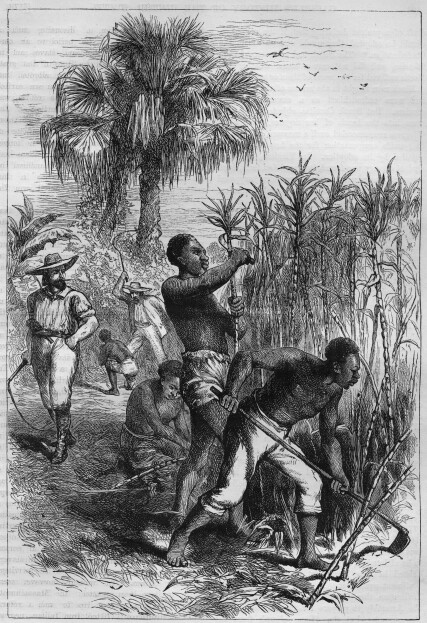
Enslavement in Upper Canada
History of Enslavement in Upper Canada (UC)
Enslaved people of African descent were brought into UC by Loyalists fleeing the United States during and following the American Revolution. White colonists from all walks of life enslaved people. Merchants, farmers, the political elite, and more used enslaved people to help the new British colony and its settlers grow and prosper. To help UC flourish, the British government paid white loyalists 40 shillings for every enslaved person that they brought into the province.
When the first Lieutenant-Governor, John Graves Simcoe, arrived in Niagara in 1792, he was surprised at how many enslaved people were already in the province. Simcoe was a known supporter of abolition and would soon speak out against it in the legislature.
When we think of the transatlantic slave trade, we often think of the trafficking of Africans, but it was more than that. The slave trade also encompassed the importing of goods like sugar, rum, tobacco, and molasses. And Upper Canada certainly benefited from these products.
By the turn of the 1800s, attitudes towards the enslavement of people of African descent were changing. In 1807, the slave trade was abolished throughout the British Empire, making it illegal to buy and sell humans. But this did not outlaw having and exploiting enslaved people. That ended, in the British Empire, in 1834.
The enslavement of people in Canada has been around longer than it has been abolished.
Life of an Enslaved Person
Enslaved men cleared land, chopped wood, and built homes. In agriculture, both enslaved men and women planted and harvested crops, and tended to livestock. Enslaved women, like Chloe Cooley, also worked as domestics and cared for their enslavers’ children.
When there was not enough work, enslaved people were often hired out so that enslavers could continue to reap financial benefits.
Enslaved people laboured long, gruelling hours, and were always at the mercy of their enslavers. Enslavers often subjected enslaved people to horrible working and living conditions and physical and sexual abuse was a frequent threat.
Many enslaved people were bound and determined to resist their enslavement. They would assert their humanity, refuse to work, steal property, or run away from their enslavers.
But every enslaved person had their own story and their own experience. Here are just a few:
Henry Lewis
Henry Lewis was enslaved in Newark (Niagara-on-the-Lake) by William and Hannah Jarvis. Lewis resisted his enslavement by running away to New York, where he could be free. Henry wrote to Jarvis requesting to buy his freedom. In Henry’s letter, he states his desire to be able to be a free man, to be able to support himself, and to “enjoy all the benefits which may result from being free in a country where a Black man is defended by the laws as much as a white man….”
Henry also explains that he fled because William’s wife, Hannah, made life unbearable. He believed that no man should have to suffer the way he did. The confession Henry makes helps us understand, to some degree, the mistreatment those enslaved by the Jarvises may have endured. William granted his request.
Peggy Pompadour
Peggy was a Black enslaved woman who was owned by Peter Russell, receiver general and member of the executive council of Upper Canada, and his sister, Elizabeth. Peggy was a domestic in their house cooking, doing laundry, and making candles and soap.
Elizabeth often complained about Peggy, calling her “dirty, idle, and insolent." As a form of resistance, Peggy frequently ran away. As punishment, Russell would confine her in jail. At one point, Elizabeth gave away her daughter, Milly. Was this a form of punishment? We may never know, but Russell later tried to unsuccessfully sell Peggy and her son, Jupiter.
Robert Jupiter
Robert Jupiter was enslaved by the Servos family for many years. Based on Servos family ledgers he was forced to help the family with their business by delivering hay locally. In 1804, Robert married Mary Ann Arrishaw and they eventually had three children. Jupiter was likely manumitted by the time the War of 1812 started, as he was listed on the muster roll and pay list of the Coloured Corps in 1813. This Corps served in the Battles of Queenston Heights and Stoney Creek during the War of 1812. Later, they were artificers who contributed to the building of Fort Mississauga.
Words Have Power
Slave. Fugitive. Master. These are words that you may be familiar with, but as we continue to study history, we have come to understand that words can have lasting power. These terms are now being replaced with enslaved person, freedom seeker, and enslaver. But why?
By changing the noun—slave—to an adjective—enslaved—the term now describes a person’s position in society rather than reducing them to that position. It helps us recognize that their state was not intrinsic to who they were as individuals.
When fugitive becomes freedom seeker the term now shows that enslaved people risked everything to make freedom a reality, rather than reducing them to a lawbreaker who deserved punishment.
Changing master to enslaver removes the appearance of power from the enslaver.
Image caption: Enslaved people working on a Plantation in the US. Slavery Images: A Visual Record of the African Slave Trade and Slave Life in the Early African Diaspora.



